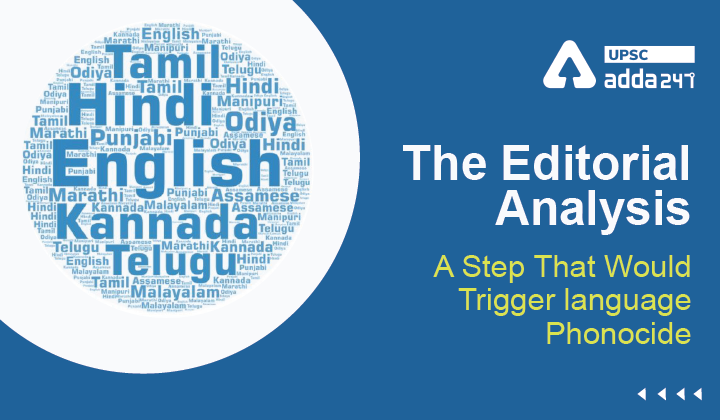Table of Contents
Hindi language controversy: Relevance
- GS 2: Functions and responsibilities of the Union and the States, issues and challenges pertaining to the federal structure.
Hindi language history: Context
- Recently, the Union Home Minister has urged the use of Hindi as the lingua franca, rather than English, in inter-State communication.
Hindi language imposition: National language of India
- D. Savarkar was the first leader who advocated the idea of Hindi to be declared the national language and articulated the slogan, ‘Hindi, Hindu, Hindustan’.
- V. Dhulekar, a member of the Constituent Assembly, stated in the Assembly, “You may belong – to another nation but I belong to Indian nation, the Hindi Nation, the Hindu Nation, the Hindustani Nation.”
- Sir George Grierson’s Linguistic Survey of India (1903-1923) had identified 179 languages and 544 dialects in India.
- The 1961 Census reports mentioned a total of 1,652 ‘mother tongues’, out of which 184 ‘mother tongues’ had more than 10,000 speakers.
- In 1971, the linguistic data offered in the Census was distributed in two categories — the officially listed languages of the Eighth Schedule of the Constitution, and the other languages with a minimum of 10,000 speakers each.
- All other languages spoken by less than 10,000 speakers were lumped together in a single entry ‘Others’.
- This practice made many languages invisible.
Hindi imposition criticism
- Hindi is not a pan-India language: According to Professor Ganesh N. Devy, wrote that ‘The Hindi’ is probably spoken by not more than 30% of the population, but it is not the mother tongue for the remaining 70%.
- Disastrous effect: In 1948, the Government of Pakistan ordained the Islamisation of East Pakistan, with Urdu as the sole national language. This decision ignited the violent Bengali language movement or Bhasha Andolan in East Pakistan. The Language Movement catalysed Bengali nationalism and the eventual separation of East Pakistan from Pakistan.
- Similarly, The Sinhala Only Act (the Official Language Act) of 1956 was a high point in Sri Lanka’s history. It triggered intense enmity and distrust between the Sinhalis and the Tamils.
- Imposing Hindi would initiate phonocide: Hindi is the first language of the residents of only 12 of the 35 States and Union Territories (in the 2011 Language Census of India, and where Andhra Pradesh and Telangana figure together in the 2011 data). Making Hindi as a lingua franca would initiate the phonocide of other Indian languages.
- Prosperity in multi-lingual nations: Singapore has a multi-ethnic population (Chinese, Malay and Indian). In its formative years, there was immense pressure to declare Chinese as the official language of Singapore. But Lee Kuan Yew, the architect of modern Singapore, quelled the demand and opted for English. English language proficiency made the city state a global business hub.
- Similarly, in South Africa, the national anthem since 1997, is a five-language lyrical composition, making it the most unique anthem in the world in this regard.
National language of India: Way forward
- India should emulate the multi-linguistic accommodative policy of Singapore and South Africa; not the disastrous linguistic chauvinism of Pakistan or Sri Lanka.
Read current affairs for UPSC





 TSPSC Group 1 Question Paper 2024, Downl...
TSPSC Group 1 Question Paper 2024, Downl...
 TSPSC Group 1 Answer key 2024 Out, Downl...
TSPSC Group 1 Answer key 2024 Out, Downl...
 UPSC Prelims 2024 Question Paper, Downlo...
UPSC Prelims 2024 Question Paper, Downlo...





